Read also:
How to Watch FX Live Without CableHow To Watch AMC Without CableHow to Watch ABC Without CableHow to Watch Paramount Network Without CableAnton Corbijn’s biopic of Joy Division singer Ian Curtis remains a tactful, fearfully accurate depiction of life while suicidal.
CONTENT WARNING: This piece contains frank discussion of suicidal thoughts and ideation. If you find yourself struggling with thoughts of suicide or self-harm, please contact resources such as the National Suicide Prevention Hotline at 800-273-8255.
I am but a bundle of impulses. Whatever I feel I think; much of what I think I do. But I’m so afraid I’ll do what I feel.
There is no thought when the line between body and mind annihilates itself. What once was thought is now process. By its side is performance, expression’s tenebrous complement. I don’t know which is which at times, my consciousness a tad flatter, my heart beating a little faster. They’re fool’s errands to untangle and, as far as I can understand, impossible for others to see. My words, my existence, give the reasons, ones to overlook. I believe this to be true and know it in the deepest crevasses of my self. That self is suicidal. If people don’t see me that way, the world does.
In Anton Corbijn’s feature debut, Control, now 15 years from its Cannes Film Festival premiere, surroundings peer through that self. Concert halls, flats, and kitchens are austere enough to confront the thoughts within. Medications, alcohol, and furniture of all things see the pits of despair. The self stares not back at it but past it, putting a pin in what’s to come. Such is suicidal life: unconsciously processing, even hoping to know, what could kill the body and release the self. The brightest moments of electricity come with the deftest realizations. The inevitability of the body’s failure is life, those impulses force.
For a film to recognize these truths is affirmative. To see it in a biopic is as intimate as it is dissociative, a tone this one carries. I am not Ian Curtis. No one is, was, or will be. He was a great artist and just another person, and rather than uphold or even demythologize his history as the lyricist and vocalist of Joy Division, Control ignores it near altogether. Its source is Touching from a Distance, Deborah Curtis’ biography of her late husband. Screenwriter Matt Greenhalgh and especially Corbijn, who worked with the band in addition to myriad others, know the banality at hand as eschatological.
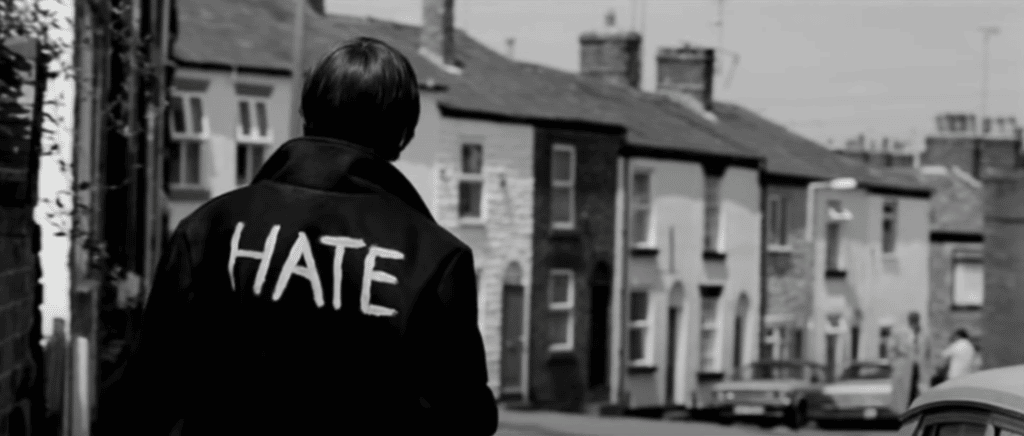
Curtis killed himself early in the morning of May 18, 1980. It was immediately before the band was set to embark on a United States tour, an anxiety exacerbated by his epilepsy, depression, and personal life. His death is not the purpose of Control but its known endpoint. It is, through its refusal to interrogate, an impulse one cannot replicate but only refract. Just as such, one cannot recreate another’s self in reality, but through the screen, Corbijn and Sam Riley—in his first role beyond three television productions—approach Curtis as as much of a character as a person. He is simply Ian.
In 1970s Macclesfield, England, Ian’s an art-rock fan and an archetypal schoolboy. He zones out, experiencing a minor seizure. His gaze meets the chalkboard. It stares at him, he at the camera—we. By chance, his connection to the world begins to go. Such is all he knows—all I know. That sense of living others clench is already becoming a farce. It’s going and, at such a young age, the myth of the mental is ceasing before the physical. Through existing around him, the world has put him on a stage. If suicidality wavers through a spectrum of solipsism and obsequity, Control knows existence as performance.
There is no real plan, no end purpose. How could there be? There’s too much to digest. Corbijn and DP Martin Ruhe shot Control in color and printed its negatives onto black-and-white film, giving a world just overflowing with contrast but diminishing in texture. It’s a bit too warm; the inactivity is overstimulating. The split between contrast and texture is subconsciously uncanny. The cognitive dissonance at hand is not one of feelings good or bad but ones different. Interest in the world wanes unless the body finds a means to live a bit more. The self cannot exist alone; it relies on the senses.
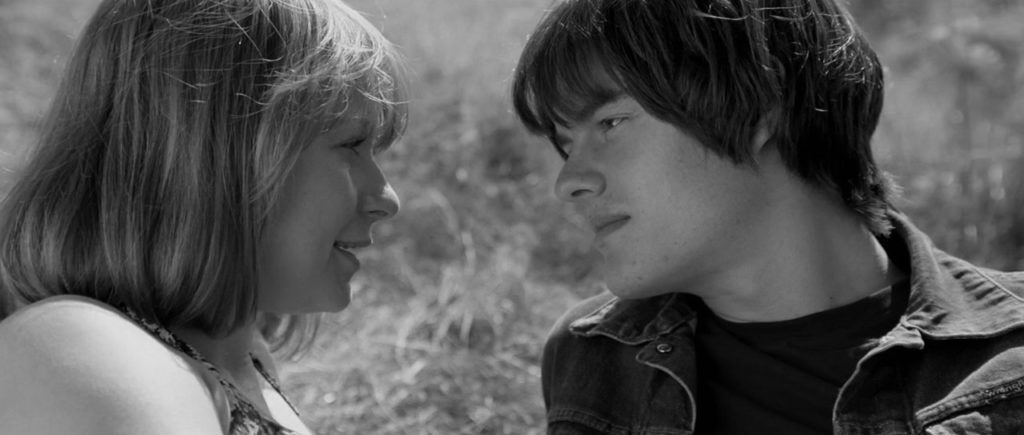
Early in the film, Ian meets Deborah Woodruff (Samantha Morton). They have a few sweet moments together, he even suggesting via voiceover their relationship is as ephemeral as it is ethereal, likening it to something on a movie reel. He suggests marriage, not really proposing. They follow through, not because it’s right for them, but because it propels his self.
Soon after, bassist Peter Hook (Joe Anderson), guitarist Bernard Sumner (James Anthony Pearson), and drummer Stephen Morris (Harry Treadaway) start a band. Terry Mason (Andrew Sheridan) steps into the role of a touring manager. Then Ian, recently beguiled by a Sex Pistols show, volunteers as a member. Despite his lyrics’ passion, the film’s distance again cues his joining as an impulse. There’s little internal motivation beyond what feels right in the moment, as if the former were such a thing to have ever existed.
Love of one’s work may signify a sense of growth for some, and often times it does. In Corbijn’s film, it evokes a temporary stimulation brought on as much by curiosity and distraction as it is connection. Interests are one’s essence, happenstance. In Control, Joy Division’s songs are as much a Greek chorus as they are suicide notes performed for scarce audiences. People hear but don’t listen, watch but don’t see. They don’t really care, and those who do don’t know what to do.
In the onscreen world, there are endless warning signs. In retrospect, Greenhalgh pulls from Joy Division’s live shows—performed and emulated to the umbrae by the cast—as checkpoints for the film’s structure. Corbijn, all the while, uses them to signify shifts in sensation and perception. Whereas the rest of Control exhibits the hard-edged, expressionism-rooted photography known to Corbijn, he and Ruhe recalibrate their outlook when Joy Division is onstage.
If suicidality wavers through a spectrum of solipsism and obsequity, Control knows existence as performance.
The first performance is at last when the pair uses handheld camerawork. It’s also when they understand their camera as subject and their hero as object, an intimation of the suicidal self-body dynamic. The camera bobs, Riley within, Ian holding himself afloat as onlookers threaten his body secondhand. He sings “Leaders of Men,” its progression akin to David Bowie’s “Queen Bitch.” Ian holds the microphone to his face, bandmates’ shadows bouncing above, he inhaling back his inspirations and own words as expression falls out.
It goes well enough for what it is: a passion project in the moment. The band prepares to record an EP, An Ideal for Living. He and Debbie plan to front the bill at the latter’s reluctance. Riley recalibrates Ian’s lanky body language into sternness, a fluke of confidence never to arise at the right moment. Debbie voices concerns; his shape turns lighter, inquisitive. She mentions money; his words turn hopeful, spoken to her away from the camera. Then, back in its view, his face lifts. Naïveté, softness. In just a moment, he regresses mentally as he shines physically. He suggests they have a baby. Debbie agrees.
Meanwhile, Joy Division performs more. Ian comes into his own dancing with “Digital,” the direction and Andrew Hulme’s editing stepping back not to neutralize but normalize the excitement in its comparative stillness. However, his lyrics here act as a premonition. “I feel it closing in / I feel it closing in / Day in, day out / Day in, day out…” he sings. Then as they perform “Transmission” on Something Else, the camera starts to erode its own accuracy.
Combined with the film’s printing technique, Cobijn and Ruhe lean subtly but solidly into subjectivity, maintaining its 2.35:1 aspect ratio in the context of a 4:3 broadcast. The camera movements keep the latter’s visual style throughout. Its pans, pedestals, and zooms are slow and fluid. Compositions, however, oscillate.
Some hold the mise-en-scène of the rest of the film: widescreen and full from side to side. Others project the look of a broadcast onto the 2.35:1 ratio, accruing emptiness around the edges. Aesthetically, the choices read as simple period detail extrapolated onto the silver screen. Thematically, they blur perception—what one feels versus what others see. The spouts of growing negative space are Ian’s reality, but as his family watches from home, their image of him is as full as it ever was.
He performs more. The band treks to London and he sings “Insight,” no shot of a non-existent crowd, the production muted as to emphasize Riley’s voice. But Ian carries the light of someone whose corpse is sweating tears. The body is shedding the self, the camera all but stuck on him. There’s no one to watch him apart from Bernard to his right.
The body and mind have already leaked past others’ gazes, that of the world and of those surrounding. On the drive back home, Ian suffers his first recognizable seizure and is diagnosed with epilepsy. The separation of body and self is now diagnosable, irreversibly in progress. The two are battling for control of their vessel. Doctors prescribe medication and offer advice incongruous to a lifestyle he’s happened to fall into: “getting plenty of early nights and steering away from alcohol.” Of course, to think that’s likely is childish.
Ian begins to avoid Debbie. He learns a client from his day job has died of a seizure; he writes “She’s Lost Control” out of fear. Debbie gives birth to a baby girl, Natalie (Eady Williams), and then, after a performance of “Candidate,” he meets Annik Honoré (Alexandra Maria Lara). A Belgian Embassy worker, she interviews Joy Division for her zine. The two hit it off, his bandmates passed out across furniture around them, a circle of artistic inspiration and obligation surrounding the two. He confides in her that his marriage was a mistake.
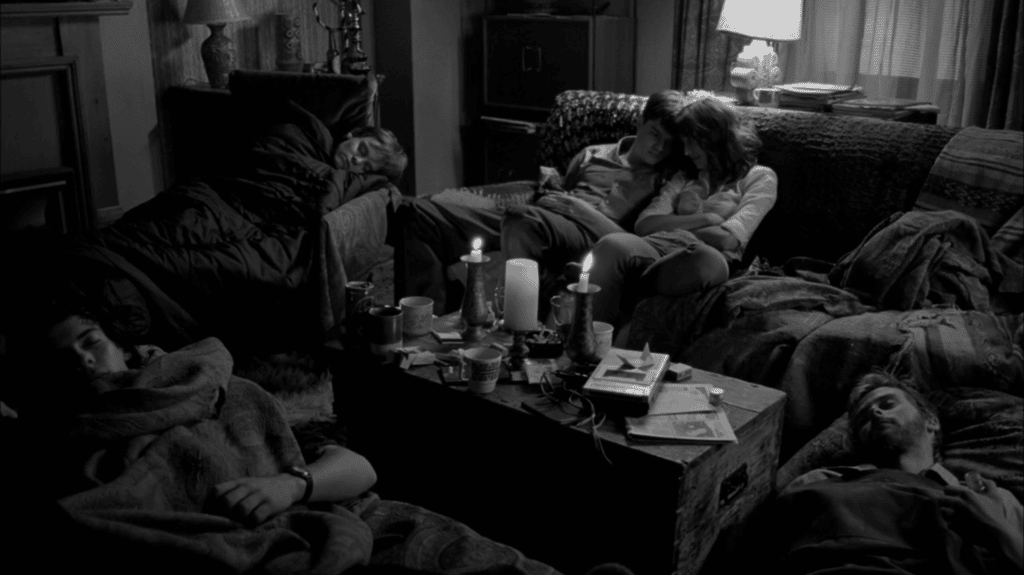
It’s at the film’s midpoint that Ian returns home, at which point Corbijn and Greenhalgh reorient his worldview. The concept of performance once associated with the stage is now ubiquitous, and the domesticity is crushing. The laundry pulley in the kitchen hangs in front of him. His body in the bathroom mirror doesn’t look to be going, but it feels like it does. When he stares through the looking glass and opens the medicine cabinet, he sees something more salient beyond his reflection. It’s a swath of pill bottles that, in close-up, shot/reverse shots, tempts the self.
He continues to neglect his family and confesses his lapsed love for Debbie. (It’s also here that Control falters one of two times, opting for an obvious “Love Will Tear Us Apart”-set montage.) She finds out about Annik. He apologizes, perhaps out of a hardwired sense of indecision deep in the body and guilt plaguing the self. But he’s also learned that Joy Division is touring the United States in just a few months, and he’s still reluctant to sort out his medication. One cannot help a self who does not want to get better. He returns to Annik, and his condition worsens.
It’s then that, in another blend of thematic and technical progression, the band performs “Dead Souls.” Now the air is just as visible as the people within it. The depth of field has furthered, the compositional variation heightened to almost random extents at moments. The body is losing its tether to the world. The expressionism established thus far trades blows with impressionism via comparatively exaggerated texture and strobe editing, and Ian has a seizure mid-performance before being dragged backstage. The act is slipping. His peers, all the while, nurse his condition with little more than idle jokes.
By now, the internal has fallen perpendicular to the external. Outreach is impossible because there’s nothing to grasp. In the next scene, Annik acknowledges her own inability to see Ian’s self. “I’ve never felt this way before. But at the same time I feel like I don’t really know anything about you,” she tells him. Yet one cannot actually know the self of another whose reluctance to get better drives them. For Ian, that bundle of impulses is dulling and that once-known self is running out of things to react to. The vessel is more of a fleshy bag of cortisol.
[T]hat bundle of impulses is dulling and that once-known self is running out of things to react to. The vessel is more of a fleshy bag of cortisol.
That non-linear trajectory is what pushes Control into something knowable to the suicidal in its last half-hour. Ian comes back home for a moment, at which point Corbijn and Ruhe present a shot of him from Natalie’s point of view. For once his self is seen: imposing, aloof, framed between bars. But being seen by an infant? It’s too undiluted, a call to reach out only possible to perceive as invasive. Ian leaves. He gets drunk alone and takes all his pills, Debbie intervening as he passes out. He recovers. The suicide has failed. The illusion of agency is dead.
“It’s like it’s not happening to me but someone pretending to be me, someone dressed in my skin,” Ian’s voiceover relays. He’s driven away, the camera in the car, he in the foreground, Debbie and the hospital in the background. Seconds later, the shot reverses and repeats itself, the camera taking Debbie and the hospital’s point of view. The sight of the self untethers in tandem with the death of the relationship. To his bandmates, Ian specifies he was drunk during the attempt as if to say, It wasn’t me who did it.
And that unconscious detachment makes it seem better. During a performance of “Disorder,” Ian’s mental debilitation leads him to bail. Whereas the body previously engulfed him onstage, now the self has. He, the vessel, has neither to trust. The crowd starts a riot. (The scene marks the second of the picture’s weak points, its buildup too linear and pacing too mannered.) Ian’s sure everyone hates him; not a while after, Debbie learns of his continued affair with Annik and calls for a divorce.
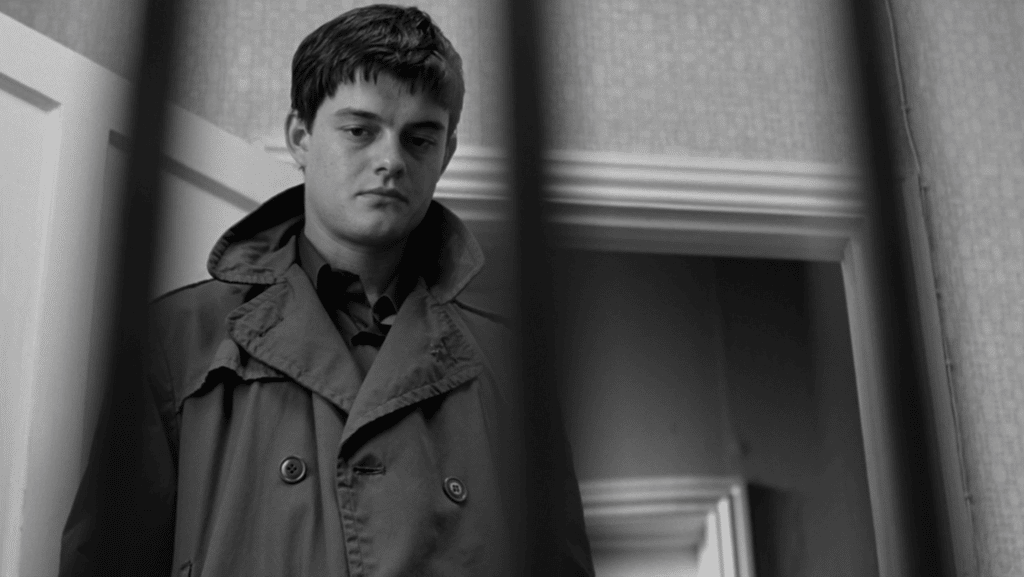
Now in his final days, his vessel—that bundle of impulses I personally know and serve—transitions into a nomad. He moves in with Bernard, who tries hypnotherapy on him. He sits, eyes closed in peace. The camera rotates around him in Control’s one steadycam shot, examining the body as the self cries from the off and the mise-en-scène finds peace. Memories, others’ words, his thoughts—all are inextricably tangled until a vision of a rope tightening. Silence. Clarity. True, unromanticized. But as he and Bernard listen back to his words from the session, he becomes traumatized.
He moves back in with his parents and writes Annik a letter. He then drifts back to what was briefly his home with Debbie, watches Werner Herzog’s Stroszek, and downs more than half a bottle of whiskey. Then, as Debbie returns home, she and the camera manage to see the self: a slumped, black silhouette, briefly appearing as hanged before floating into view. He asks for another chance, but Debbie refuses, at which point he shouts at her to leave until tomorrow. Alone, he listens to Iggy Pop’s The Idiot. He has the seizure of an animal, awakes in the morning, and stumbles to the kitchen.
The laundry pulley sees him from above. He matches its gaze and gives himself to it.
The self is lost. Debbie discovers Ian. The hero is soon cremated and body and self are together—gone.
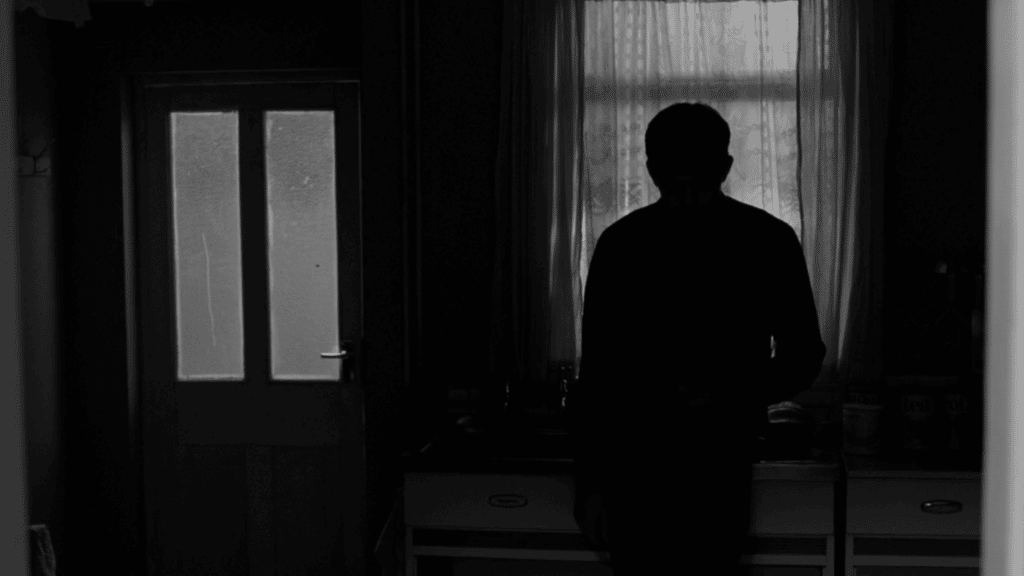
As I watch Control, I relive my loss of texture and growth of contrast. The darks are darker and the lights are overbearing, but to call my existence black-and-white would be infantile. That nonlinear format of life leading to that same destination I cannot look past is my essence. Thoughts of suicide for me are not idle curiosity. They are premonitions alarmingly similar to the way Corbijn deromanticizes Curtis and his passing through recontextualizing it. It’s a tale universal to those selves who can relate, and that it manages such is a testament to its modesty. It’s art that knows reasons, not answers.
I can’t say my self has many answers either. I know what I know, or at least whatever my senses let me. My self is at their mercy. And yet, as impossible as it may be, I see my self on screen here. I hold onto personal relationships for dear life, but only some. I wander through the world, curiosity spurring my body into action with its mind in tow. At night, I float through my thoughts, wondering, knowing, what my final hours will be. In Control, I see a better part of them.
Over the past few months, terrible nightmares have plagued me. They get bigger every time. In them, people I know, some not even personally, tell me it won’t be long before I kill myself. I say they’re probably right and am ambivalent about the prospect. Then as I wake up, I remain traumatized for the entire day. One morning a few weeks ago, I jolted awake, thinking I heard a beeping. Hypnopompic, I was unsure if it were the dream or reality. All I could do was lie in bed for six hours, stare at the sky, and listen to Joy Division’s Closer on repeat.
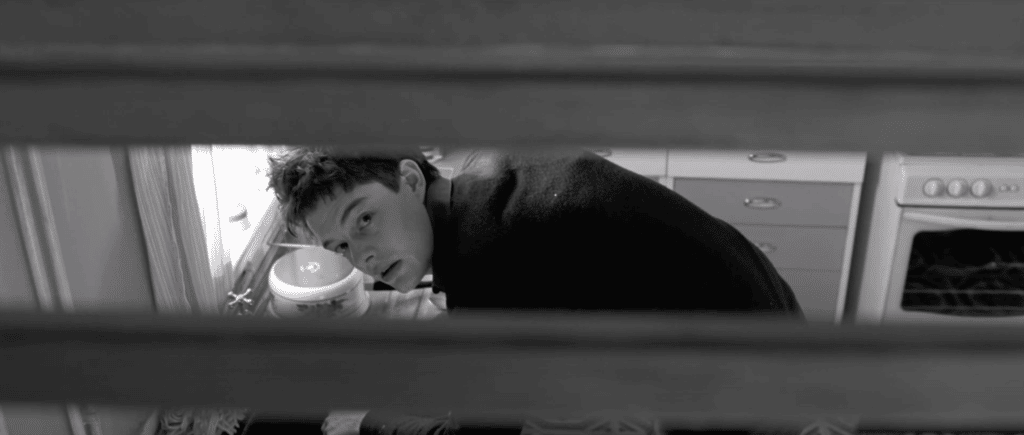
Later that night just as I prepared to go to sleep, I realized what the beeping noise was: my self heard the sound of my body flatlining. The next morning, I awoke hearing a rope tighten. It was just the rain hitting my window. I felt as if I saw my self in the world as it dribbled on the glass. It was as if, through the trees’ movement, I watched my body sway violently in the wind. In such moments, I am alone, but self and body feel fuller. I see my mind a little more clearly, and like Ian listening back to his thoughts, the insight I’ve gleaned is invaluable.
That self still grapples with suicidal thoughts, but it still has its curiosities. They’re as confrontational as Control isn’t, and in that complement, the film is my body to see—for my self to learn from. I may still be a bundle of impulses. For two hours, something in the world sees me.